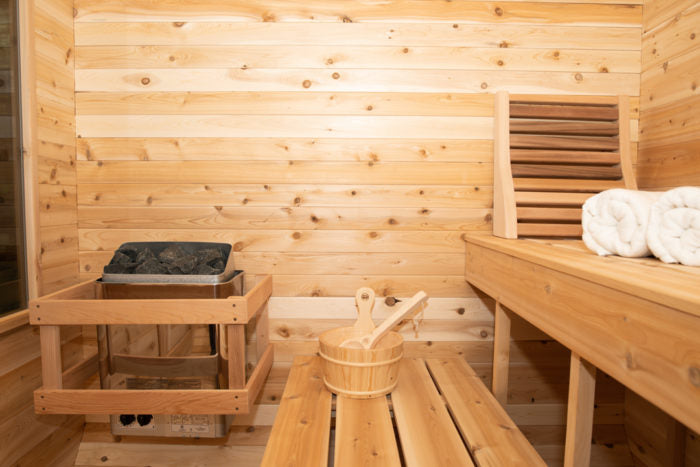About Traditional Sauna
About Traditional Sauna
Blog Article
Facts About Traditional Sauna Uncovered
Table of ContentsGet This Report about Traditional SaunaThe Ultimate Guide To Traditional SaunaAn Unbiased View of Traditional SaunaWhat Does Traditional Sauna Mean?
Many of the weight lost in a sauna is water loss and is re-gained upon rehydrating. Without a question sauna can be an important part of a healthy weight loss program. To consider the differences between conventional and IR saunas, I will certainly separate these into proven, theoretical, and produced distinctions.Hence, the best point in the saunawhich goes to the ceiling straight over the sauna heateris normally between 185 and 190 F. Traditional Sauna. Claims that a conventional sauna goes beyond 200 F is just not true and not appropriate for electrical saunas offered in the US. The temperature for a far-infrared sauna is generally set between 120 and 140 F; however, unlike the standard sauna, the goal in and IR area is not to accomplish a heat
As a result of this, the temperature difference is nearly pointless, given that profuse sweating causes both sauna kinds, however the approach of warming the body is various. In an IR sauna the bather will certainly feel hot and will sweat a lot, but at much lower temperatures. Therefore, if the objective is to spend longer periods of time in the sauna, the IR sauna is a great option.

Fascination About Traditional Sauna
When the high temperature is achieved, the aspects cycle on and off to maintain the heat. A lot of typical sauna users take pleasure in putting water over the rocks to produce steam to increase sauna moisture degrees. The benefits of pouring water over the rocks include: making the room a lot more comfortable, dampening the nasal flows, and permitting the usage of aromatherapy by blending essential oils with the water.
In a far-infrared sauna, the warm waves pass through the body to efficiently heat the body and raise the body core temperature level. To achieve this enhanced temperature level, Far-infrared emitters create infrared power which is close to the very same wavelength as that which the body naturally emitsoften referred to as the "Important Array" of 7 to 14 microns), so the power is well received by the body.
When the power goes into the body, it causes the body temperature level to raise and inevitably leads to sweating. In an infrared sauna it is necessary for the emitters/heaters to stay on nearly frequently. Given that there is no mass of rocks to maintain warmth, the sauna will cool if the emitters turned off.
As stated over, the sauna bather in an infrared area intends to position himself before running emitters to get maximum benefit from the warmth. The home heating time for both rooms can be extremely various, depending on just how the spaces are utilized. For a typical sauna, a bather should permit 30-40 mins for the area to attain a preferred temperature and to appropriately pre-heat the rocks.
A Biased View of Traditional Sauna
A well built sauna will generally accomplish a temperature of 150-160 F in about 30-40 mins. For hotter temperature levels, the room might require to warm for a longer period.
To some, 15 minutes was "thrown away" while the infrared energy heated up the wood panels as opposed to warming a body, while others discover a pre-heated area to be a lot more comfortable and think an elevated beginning temperature is essential to start sweating. The length of suggested use for every space is approximately the exact same (10-15 mins per session); nevertheless, as a a fantastic read result of the lower air temperatures and the capability to really feel the results of infrared warmth faster than a traditional sauna, it is not unusual for an individual to invest a total of 20-30 minutes in an infrared sauna.
Traditional saunas often tend to be bigger (for this reason utilize more electrical energy) than infrared saunas, although standard saunas are certainly offered in one and 2 individual sizes too. For a two-person traditional sauna, 5x6 or 5x7 dimension is most preferred. The top bench can comfortably seat 2 or three individuals and is likewise long enough to relax throughout the sauna session.


The ordinary cost per kWH of electrical power in the united state is approximately $0.11, so a 4.5 kW heating system will certainly set you back around $.50 to compete one hour, if the heating unit runs continuously for one hour. Usually a sauna heater will certainly compete 75% of the first hour and 50% of subsequent hours on considering that the aspects cycle once the set temperature is attained.
The smart Trick of Traditional Sauna That Nobody is Talking About
A two person far-infrared area is usually physically this post smaller than a conventional sauna, usually regarding 4' x 4' or smaller sized. The IR home heating system is commonly 1.5-1.7 kW making use of a 120 volt 15 amp plug-in service. Because the space can be made use of earlier than a sauna room, we will assume the space is utilized for to of an hour including warmth up time.
Ultimately, there is a rarely discussed distinction in the social experience between the 2 rooms. While our society has lost several of the social advantage of the standard sauna experience, it can be extremely socially satisfying. From household time in the sauna, to heart-felt discussions with loved ones, to sauna partiesthe conventional sauna experience can bring about intimate mingling.
Many greater end from this source infrared rooms include colored light therapy, sound systems and full-glass fronts.
Report this page